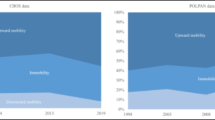Abstract
The increasing interest in subjective as well as objective measures of well-being raises the issue of the relative importance of these two different types of measures when they are included as independent variables in analytical or predictive models. In the research reported here, survey data are used to evaluate the relative importance of objective and subjective indicators in providing an understanding of why households desire to move. Overall, it is found that subjective indicators add considerably to the explanation of mobility inclinations over and above that contributed by objective indicators. A comparison of explanatory powers for the full sets of objective and subjective predictors within two length of residence subgroups indicates some interesting differences, however. Objective and subjective predictors are close in explanatory power for longer-term residents, while subjective measures are considerably more important for shorter-term residents.
Similar content being viewed by others
Bibliography
Andrews, Frank M. et al.: 1973, Multiple Classification Analysis, Institute for Social Research, Ann Arbor, Michigan.
Campbell, A.: 1971, ‘Social Accounting in the 1970's’, Michigan Business Review XXIII, 2–8.
Campbell, A. and Converse, P.: 1972, The Human Meaning of Social Change, Russell Sage Foundation, New York.
Duncan, Greg and Newman, Sandra: (forthcoming), ‘People as Planners: The Role of Expectations in Prospective Residential Mobility’, J. Morgan (ed.), Five Thousand American Families—Patterns of Economic Progress, Vol. III, Survey Research Center, Ann Arbor, Michigan.
Foote, N. et al.: 1960, Housing Choices and Housing Constraints, McGraw Hill, New York.
Marans, R. and Rodgers, W.: 1974, ‘Toward an Understanding of Community Satisfaction’, A.Hawley and V.Rock (eds.), Urbanization — The State of Knowledge, National Academy of Sciences, Washington, D.C.
Newman, S.: 1974, The Residential Environment and the Desire to Move, Institute for Social Research, Ann Arbor, Michigan.
Robinson, J.: 1973, ‘Measures of the Quality of Urban Life’, Paper presented at Conference on the City in History, Ann Arbor, Michigan.
Rossi, P.: 1955, Why Families Move, The Free Press, Glencoe.
Sonquist, J. et al.: 1971, Searching for Structure, Institute for Social Research, Ann Arbor, Michigan.
Withey, S.: (forthcoming), ‘Values and Social Change’, B. Strumpel (ed.), Subjective Elements of Well Being, OECD, Paris.
Author information
Authors and Affiliations
Rights and permissions
About this article
Cite this article
Newman, S. Objective and subjective determinants of prospective residential mobility. Soc Indic Res 2, 53–63 (1975). https://doi.org/10.1007/BF00300470
Received:
Issue Date:
DOI: https://doi.org/10.1007/BF00300470




